Chenhao Li
Learning Soft Robotic Dynamics with Active Exploration
Oct 31, 2025Abstract:Soft robots offer unmatched adaptability and safety in unstructured environments, yet their compliant, high-dimensional, and nonlinear dynamics make modeling for control notoriously difficult. Existing data-driven approaches often fail to generalize, constrained by narrowly focused task demonstrations or inefficient random exploration. We introduce SoftAE, an uncertainty-aware active exploration framework that autonomously learns task-agnostic and generalizable dynamics models of soft robotic systems. SoftAE employs probabilistic ensemble models to estimate epistemic uncertainty and actively guides exploration toward underrepresented regions of the state-action space, achieving efficient coverage of diverse behaviors without task-specific supervision. We evaluate SoftAE on three simulated soft robotic platforms -- a continuum arm, an articulated fish in fluid, and a musculoskeletal leg with hybrid actuation -- and on a pneumatically actuated continuum soft arm in the real world. Compared with random exploration and task-specific model-based reinforcement learning, SoftAE produces more accurate dynamics models, enables superior zero-shot control on unseen tasks, and maintains robustness under sensing noise, actuation delays, and nonlinear material effects. These results demonstrate that uncertainty-driven active exploration can yield scalable, reusable dynamics models across diverse soft robotic morphologies, representing a step toward more autonomous, adaptable, and data-efficient control in compliant robots.
Motion Priors Reimagined: Adapting Flat-Terrain Skills for Complex Quadruped Mobility
May 21, 2025Abstract:Reinforcement learning (RL)-based legged locomotion controllers often require meticulous reward tuning to track velocities or goal positions while preserving smooth motion on various terrains. Motion imitation methods via RL using demonstration data reduce reward engineering but fail to generalize to novel environments. We address this by proposing a hierarchical RL framework in which a low-level policy is first pre-trained to imitate animal motions on flat ground, thereby establishing motion priors. A subsequent high-level, goal-conditioned policy then builds on these priors, learning residual corrections that enable perceptive locomotion, local obstacle avoidance, and goal-directed navigation across diverse and rugged terrains. Simulation experiments illustrate the effectiveness of learned residuals in adapting to progressively challenging uneven terrains while still preserving the locomotion characteristics provided by the motion priors. Furthermore, our results demonstrate improvements in motion regularization over baseline models trained without motion priors under similar reward setups. Real-world experiments with an ANYmal-D quadruped robot confirm our policy's capability to generalize animal-like locomotion skills to complex terrains, demonstrating smooth and efficient locomotion and local navigation performance amidst challenging terrains with obstacles.
Offline Robotic World Model: Learning Robotic Policies without a Physics Simulator
Apr 23, 2025Abstract:Reinforcement Learning (RL) has demonstrated impressive capabilities in robotic control but remains challenging due to high sample complexity, safety concerns, and the sim-to-real gap. While offline RL eliminates the need for risky real-world exploration by learning from pre-collected data, it suffers from distributional shift, limiting policy generalization. Model-Based RL (MBRL) addresses this by leveraging predictive models for synthetic rollouts, yet existing approaches often lack robust uncertainty estimation, leading to compounding errors in offline settings. We introduce Offline Robotic World Model (RWM-O), a model-based approach that explicitly estimates epistemic uncertainty to improve policy learning without reliance on a physics simulator. By integrating these uncertainty estimates into policy optimization, our approach penalizes unreliable transitions, reducing overfitting to model errors and enhancing stability. Experimental results show that RWM-O improves generalization and safety, enabling policy learning purely from real-world data and advancing scalable, data-efficient RL for robotics.
NIL: No-data Imitation Learning by Leveraging Pre-trained Video Diffusion Models
Mar 13, 2025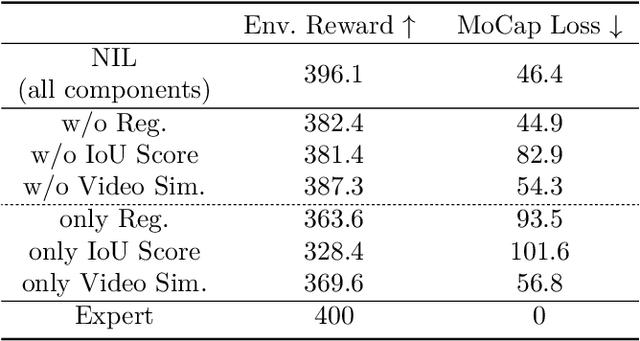
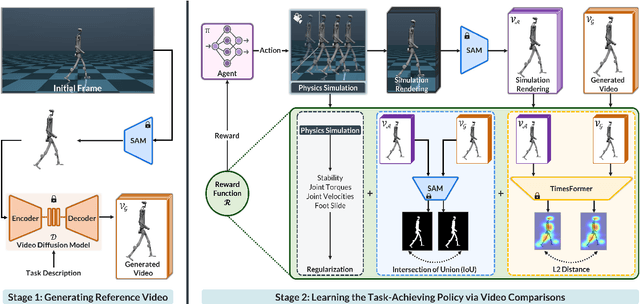
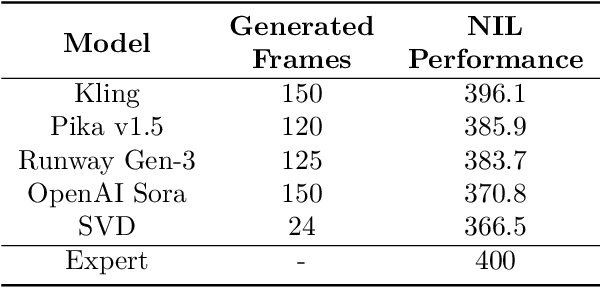

Abstract:Acquiring physically plausible motor skills across diverse and unconventional morphologies-including humanoid robots, quadrupeds, and animals-is essential for advancing character simulation and robotics. Traditional methods, such as reinforcement learning (RL) are task- and body-specific, require extensive reward function engineering, and do not generalize well. Imitation learning offers an alternative but relies heavily on high-quality expert demonstrations, which are difficult to obtain for non-human morphologies. Video diffusion models, on the other hand, are capable of generating realistic videos of various morphologies, from humans to ants. Leveraging this capability, we propose a data-independent approach for skill acquisition that learns 3D motor skills from 2D-generated videos, with generalization capability to unconventional and non-human forms. Specifically, we guide the imitation learning process by leveraging vision transformers for video-based comparisons by calculating pair-wise distance between video embeddings. Along with video-encoding distance, we also use a computed similarity between segmented video frames as a guidance reward. We validate our method on locomotion tasks involving unique body configurations. In humanoid robot locomotion tasks, we demonstrate that 'No-data Imitation Learning' (NIL) outperforms baselines trained on 3D motion-capture data. Our results highlight the potential of leveraging generative video models for physically plausible skill learning with diverse morphologies, effectively replacing data collection with data generation for imitation learning.
Toward Task Generalization via Memory Augmentation in Meta-Reinforcement Learning
Feb 03, 2025



Abstract:In reinforcement learning (RL), agents often struggle to perform well on tasks that differ from those encountered during training. This limitation presents a challenge to the broader deployment of RL in diverse and dynamic task settings. In this work, we introduce memory augmentation, a memory-based RL approach to improve task generalization. Our approach leverages task-structured augmentations to simulate plausible out-of-distribution scenarios and incorporates memory mechanisms to enable context-aware policy adaptation. Trained on a predefined set of tasks, our policy demonstrates the ability to generalize to unseen tasks through memory augmentation without requiring additional interactions with the environment. Through extensive simulation experiments and real-world hardware evaluations on legged locomotion tasks, we demonstrate that our approach achieves zero-shot generalization to unseen tasks while maintaining robust in-distribution performance and high sample efficiency.
Robotic World Model: A Neural Network Simulator for Robust Policy Optimization in Robotics
Jan 17, 2025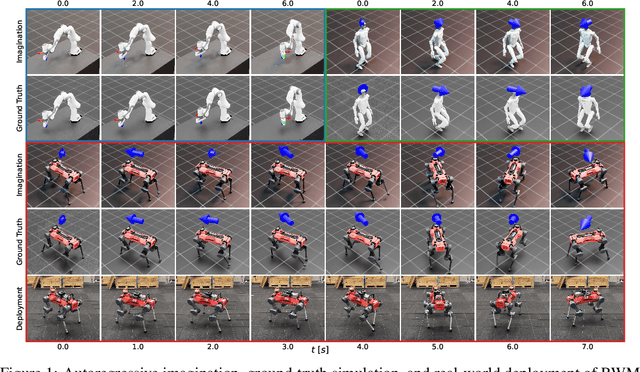



Abstract:Learning robust and generalizable world models is crucial for enabling efficient and scalable robotic control in real-world environments. In this work, we introduce a novel framework for learning world models that accurately capture complex, partially observable, and stochastic dynamics. The proposed method employs a dual-autoregressive mechanism and self-supervised training to achieve reliable long-horizon predictions without relying on domain-specific inductive biases, ensuring adaptability across diverse robotic tasks. We further propose a policy optimization framework that leverages world models for efficient training in imagined environments and seamless deployment in real-world systems. Through extensive experiments, our approach consistently outperforms state-of-the-art methods, demonstrating superior autoregressive prediction accuracy, robustness to noise, and generalization across manipulation and locomotion tasks. Notably, policies trained with our method are successfully deployed on ANYmal D hardware in a zero-shot transfer, achieving robust performance with minimal sim-to-real performance loss. This work advances model-based reinforcement learning by addressing the challenges of long-horizon prediction, error accumulation, and sim-to-real transfer. By providing a scalable and robust framework, the introduced methods pave the way for adaptive and efficient robotic systems in real-world applications.
Learning More With Less: Sample Efficient Dynamics Learning and Model-Based RL for Loco-Manipulation
Jan 17, 2025



Abstract:Combining the agility of legged locomotion with the capabilities of manipulation, loco-manipulation platforms have the potential to perform complex tasks in real-world applications. To this end, state-of-the-art quadrupeds with attached manipulators, such as the Boston Dynamics Spot, have emerged to provide a capable and robust platform. However, both the complexity of loco-manipulation control, as well as the black-box nature of commercial platforms pose challenges for developing accurate dynamics models and control policies. We address these challenges by developing a hand-crafted kinematic model for a quadruped-with-arm platform and, together with recent advances in Bayesian Neural Network (BNN)-based dynamics learning using physical priors, efficiently learn an accurate dynamics model from data. We then derive control policies for loco-manipulation via model-based reinforcement learning (RL). We demonstrate the effectiveness of this approach on hardware using the Boston Dynamics Spot with a manipulator, accurately performing dynamic end-effector trajectory tracking even in low data regimes.
Neural Predictor for Flight Control with Payload
Oct 21, 2024
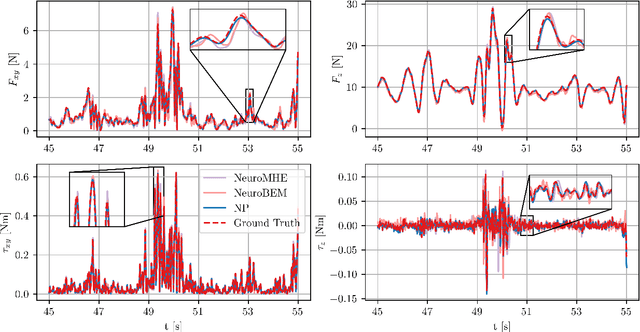

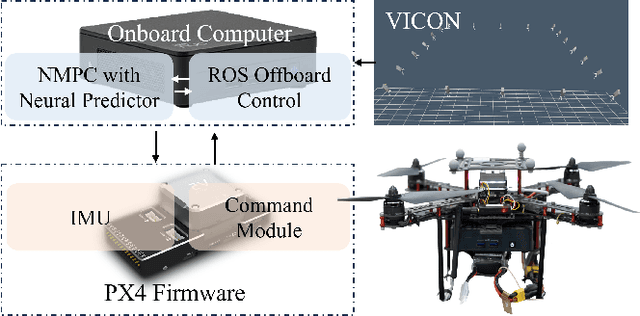
Abstract:Aerial robotics for transporting suspended payloads as the form of freely-floating manipulator are growing great interest in recent years. However, the prior information of the payload, such as the mass, is always hard to obtain accurately in practice. The force/torque caused by payload and residual dynamics will introduce unmodeled perturbations to the system, which negatively affects the closed-loop performance. Different from estimation-like methods, this paper proposes Neural Predictor, a learning-based approach to model force/torque caused by payload and residual dynamics as a dynamical system. It results a hybrid model including both the first-principles dynamics and the learned dynamics. This hybrid model is then integrated into a MPC framework to improve closed-loop performance. Effectiveness of proposed framework is verified extensively in both numerical simulations and real-world flight experiments. The results indicate that our approach can capture force/torque caused by payload and residual dynamics accurately, respond quickly to the changes of them and improve the closed-loop performance significantly. In particular, Neural Predictor outperforms a state-of-the-art learning-based estimator and has reduced the force and torque estimation errors by up to 66.15% and 33.33% while using less samples.
SMILES-Mamba: Chemical Mamba Foundation Models for Drug ADMET Prediction
Aug 11, 2024



Abstract:In drug discovery, predicting the absorption, distribution, metabolism, excretion, and toxicity (ADMET) properties of small-molecule drugs is critical for ensuring safety and efficacy. However, the process of accurately predicting these properties is often resource-intensive and requires extensive experimental data. To address this challenge, we propose SMILES-Mamba, a two-stage model that leverages both unlabeled and labeled data through a combination of self-supervised pretraining and fine-tuning strategies. The model first pre-trains on a large corpus of unlabeled SMILES strings to capture the underlying chemical structure and relationships, before being fine-tuned on smaller, labeled datasets specific to ADMET tasks. Our results demonstrate that SMILES-Mamba exhibits competitive performance across 22 ADMET datasets, achieving the highest score in 14 tasks, highlighting the potential of self-supervised learning in improving molecular property prediction. This approach not only enhances prediction accuracy but also reduces the dependence on large, labeled datasets, offering a promising direction for future research in drug discovery.
Deep Polarization Cues for Single-shot Shape and Subsurface Scattering Estimation
Jul 11, 2024



Abstract:In this work, we propose a novel learning-based method to jointly estimate the shape and subsurface scattering (SSS) parameters of translucent objects by utilizing polarization cues. Although polarization cues have been used in various applications, such as shape from polarization (SfP), BRDF estimation, and reflection removal, their application in SSS estimation has not yet been explored. Our observations indicate that the SSS affects not only the light intensity but also the polarization signal. Hence, the polarization signal can provide additional cues for SSS estimation. We also introduce the first large-scale synthetic dataset of polarized translucent objects for training our model. Our method outperforms several baselines from the SfP and inverse rendering realms on both synthetic and real data, as demonstrated by qualitative and quantitative results.
 Add to Chrome
Add to Chrome Add to Firefox
Add to Firefox Add to Edge
Add to Edge